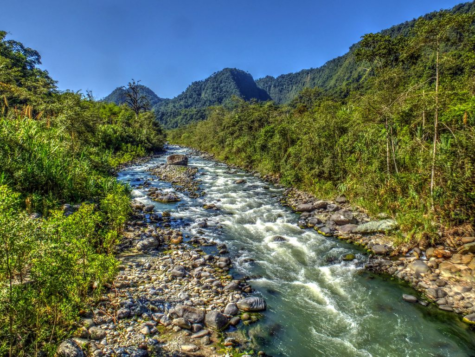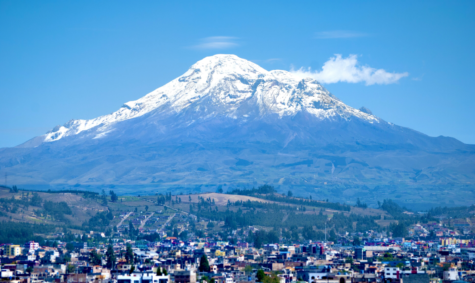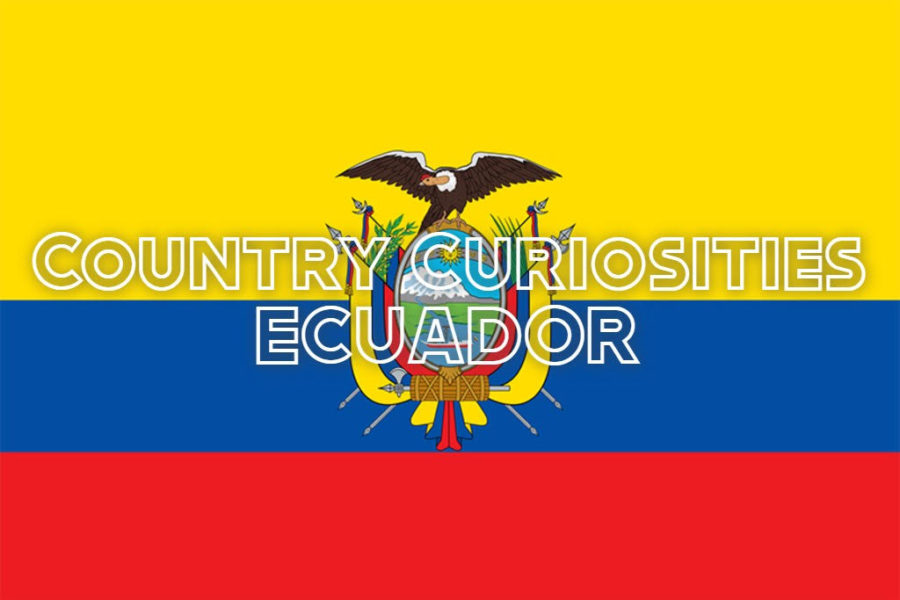Country Curiosities: Ecuador
May 29, 2021
Introduction
In South America, just to the southwest flank of Colombia and to the north of Peru lies Ecuador. Most people recognize Ecuador purely by its being named after the equator, which runs at 0 degrees latitude around the circumference of the planet. However, there is much more to Ecuador than immediately comes to mind. One would never have guessed that Ecuador is actually home to the world’s closest point to space, or rather that the rights of nature are officially recognized there. These three things only represent a fraction of the fun, exciting, and interesting aspects of the country of Ecuador!
Ecuador on the Equator
 One of the most obvious and well-known features of Ecuador is its own name. For most of its history, the land that is now known as Ecuador was ruled over by several tribes of indigenous peoples. However, the land was soon organized and conquered by the Inca civilization who were then conquered and colonized by the Spanish (Knapp). Then, for nearly three centuries, Ecuador was ruled under the Spanish Empire until they eventually gained independence from Spain in 1822 (“Ecuador Country Profile”). It would be until 1830, however, that Ecuador gained true sovereignty as it seceded from the short-lived state of Gran Colombia, a historical coalition of South American states that included Ecuador, Peru, Columbia, and more (Britannica). It was once they seceded that they embraced the toponym of “Ecuador”, inspired by what the region was historically referred to by the Spanish, which was “El ecuador”, or “The equator” (“Where does the…”). Due to its name, Ecuador stands out as the only country in the world to have a name derived from a geographic feature!
One of the most obvious and well-known features of Ecuador is its own name. For most of its history, the land that is now known as Ecuador was ruled over by several tribes of indigenous peoples. However, the land was soon organized and conquered by the Inca civilization who were then conquered and colonized by the Spanish (Knapp). Then, for nearly three centuries, Ecuador was ruled under the Spanish Empire until they eventually gained independence from Spain in 1822 (“Ecuador Country Profile”). It would be until 1830, however, that Ecuador gained true sovereignty as it seceded from the short-lived state of Gran Colombia, a historical coalition of South American states that included Ecuador, Peru, Columbia, and more (Britannica). It was once they seceded that they embraced the toponym of “Ecuador”, inspired by what the region was historically referred to by the Spanish, which was “El ecuador”, or “The equator” (“Where does the…”). Due to its name, Ecuador stands out as the only country in the world to have a name derived from a geographic feature!
The Rights of Nature
 Human rights is a valuable thing that all living people deserve. Everyday, people struggle to fight for their most basic rights. However, as people are fighting for their rights, mother nature herself is violated and mistreated on a near daily basis. The Earth’s greenery, plant life, landscapes, and wildlife are continually and increasingly being treated as insignificant and without respect. Ecuador, as one of the most biodiverse countries on this planet, has made strides to protect nature through government legislation. In the revision of their constitution in the year 2008, a chapter regarding the rights of nature was added and ratified, stating that, “nature in all its life forms has the right to exist, persist, maintain and regenerate its vital cycles” (“Ecuador Adopts Rights…”). As one of the countries in the world with a huge integration with nature, it is only right that they work to defend nature. In fact, Yasuní National Park in the Ecuadorian portion of the Amazon rainforest is one of the most biodiverse places in the world (Blitz).
Human rights is a valuable thing that all living people deserve. Everyday, people struggle to fight for their most basic rights. However, as people are fighting for their rights, mother nature herself is violated and mistreated on a near daily basis. The Earth’s greenery, plant life, landscapes, and wildlife are continually and increasingly being treated as insignificant and without respect. Ecuador, as one of the most biodiverse countries on this planet, has made strides to protect nature through government legislation. In the revision of their constitution in the year 2008, a chapter regarding the rights of nature was added and ratified, stating that, “nature in all its life forms has the right to exist, persist, maintain and regenerate its vital cycles” (“Ecuador Adopts Rights…”). As one of the countries in the world with a huge integration with nature, it is only right that they work to defend nature. In fact, Yasuní National Park in the Ecuadorian portion of the Amazon rainforest is one of the most biodiverse places in the world (Blitz).
Mountain Chimborazo
 When asked what the highest point on Earth is, most will near-instantaneously respond with “Mt. Everest”. Well, guess what? Whoever answers that is dead wrong. While, yes, Mt. Everest is the tallest mountain, it is not the tallest point on Earth. That title would go to Mt. Chimborazo, the tallest mountain in Peru and the closest point to space on the entire planet. When compared by vertical distance from sea level, Mt. Everest towers over Mt. Chimborazo, with a height difference of nearly 9,000 feet (US Department of Commerce). However, the Earth is not a perfect sphere, in fact it more resembles an oval, or something more like a kind-of squished tennis ball. Due to this, one side of the Earth has a greater distance from the core of the planet than others. Taking this into account, Mt. Chimborazo protrudes 7,000 feet farther into space than any of the Himalayas (Jennings).
When asked what the highest point on Earth is, most will near-instantaneously respond with “Mt. Everest”. Well, guess what? Whoever answers that is dead wrong. While, yes, Mt. Everest is the tallest mountain, it is not the tallest point on Earth. That title would go to Mt. Chimborazo, the tallest mountain in Peru and the closest point to space on the entire planet. When compared by vertical distance from sea level, Mt. Everest towers over Mt. Chimborazo, with a height difference of nearly 9,000 feet (US Department of Commerce). However, the Earth is not a perfect sphere, in fact it more resembles an oval, or something more like a kind-of squished tennis ball. Due to this, one side of the Earth has a greater distance from the core of the planet than others. Taking this into account, Mt. Chimborazo protrudes 7,000 feet farther into space than any of the Himalayas (Jennings).
Works Cited
Blitz, Matt. “This Park in Ecuador Is One of the Most Biodiverse Places on Earth.” Smithsonian .com, Smithsonian Institution, 22 May 2015, www.smithsonianmag.com /travel/amazonian-rainforest-one-most-biodiverse-places-earth-180955364/. Accessed 28 May 2021.
Britannica, The Editors of Encyclopaedia. “Gran Colombia”. Encyclopedia Britannica, 22 Jul. 2016, https://www.britannica.com/place/Gran-Colombia. Accessed 28 May 2021.
“Ecuador Adopts Rights of Nature in Constitution.” The Rights of Nature, GARN, 4 Sept. 2018, www.therightsofnature.org/ecuador-rights/. Accessed 28 May 2021
“Ecuador Country Profile – National Geographic Kids.” Geography, National Geographic Kids, 1 Mar. 2021, kids.nationalgeographic.com/geography/countries/article/ecuador#:~ :text=use%20is%20prohibited.-,Ecuador%20is%20located%20in%20the%20western%20corner%20at%20the%20top,splits%20the%20country%20in%20two. Accessed 27 May 2021.
Jennings, Ken. “Ken Jennings Shocker: Mt. Everest Is Not the Highest Point on Earth.” Condé Nast Traveler, Condé Nast Traveler, 6 Oct. 2016, www.cntraveler.com/stories/2012-06-04 /mount-chimborazo-volcano-ecuador-maphead-ken-jennings. Accessed 28 May 2021.
Knapp, Gregory W. , MacLeod, Murdo J. and Vélez, Homero Pozo. “Ecuador”. Encyclopedia Britannica, 10 Mar. 2021, https://www.britannica.com/place/Ecuador. Accessed 27 May 2021.
US Department of Commerce, National Oceanic and Atmospheric Administration. “What Is the Highest Point on Earth as Measured from Earth’s Center?” NOAA’s National Ocean Service, 25 June 2016, oceanservice.noaa.gov/facts/highestpoint.html. Accessed 28 May 2021
“Where Does the Name Ecuador Come from?” Welcome To Ecuador!, allaboutecuador.weebly .com/where-does-the-name-ecuador-come-from.html. Accessed 28 May 2021.






















































